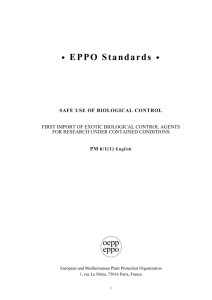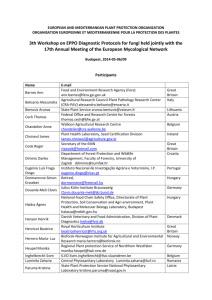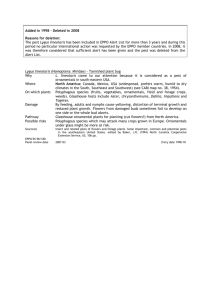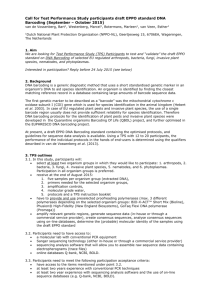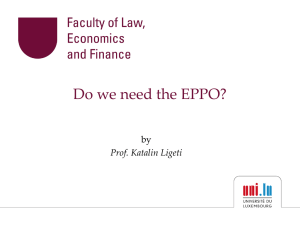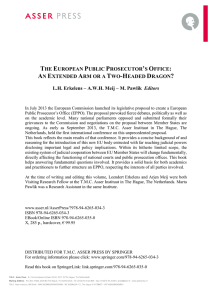Supervision of the release
advertisement
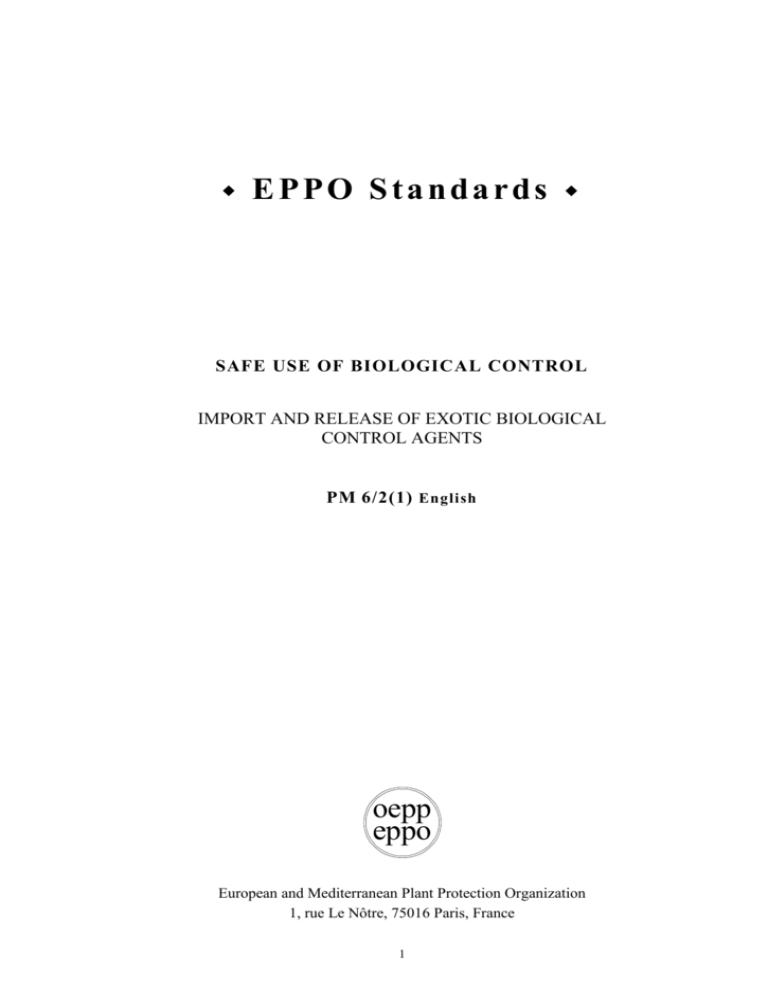
EPPO Standards SAFE USE OF BIOLOGICAL CONTROL IMPORT AND RELEASE OF EXOTIC BIOLOGICAL CONTROL AGENTS PM 6/2(1) English oepp eppo European and Mediterranean Plant Protection Organization 1, rue Le Nôtre, 75016 Paris, France 1 APPROVAL EPPO Standards are approved by EPPO Council. The date of approval appears in each individual standard. In the terms of Article II of the IPPC, EPPO Standards are Regional Standards for the members of EPPO. REVIEW EPPO Standards are subject to periodic review and amendment. The next review date for this set of EPPO Standards is decided by the EPPO Working Party on Phytosanitary Regulations. AMENDMENT RECORD Amendments will be issued as necessary, numbered and dated. The dates of amendment appear in each individual standard (as appropriate). DISTRIBUTION EPPO Standards are distributed by the EPPO Secretariat to all EPPO member governments. Copies are available to any interested person under particular conditions upon request to the EPPO Secretariat. SCOPE The EPPO Standards on the safe use of biological control are intended to be used by NPPOs or equivalent authorities, in their capacity as bodies responsible for overseeing and, if appropriate, regulating the introduction and use of biological control agents. REFERENCES IPPC (1995) Code of Conduct for the Import and Release of Exotic Biological Control Agents. ISPM no. 3. IPPC Secretariat, FAO, Rome (IT). OUTLINE OF REQUIREMENTS NPPOs of the EPPO region generally promote the use of biological control in plant protection because, like other aspects of integrated pest management, it reduces risks to human health and the environment. Use of biological control agents may, nevertheless, present some risks, in particular for the environment if exotic agents are introduced from other continents, and for the user if agents are formulated as plant protection products. In general, the latter case can be covered by EPPO Standards of series PP, concerning plant protection products. The aim of the EPPO Standards on the safe use of biological control is to provide the NPPOs with guidelines for assessing and reducing the risks associated with various aspects of the introduction and use of biological control agents and, as appropriate, for comparing them with the benefits in terms of efficacy. The EPPO Standards seek to make the administrative framework for the introduction and use of biological control agents as light as practically possible, in order to sustain a general policy of promotion of biological control. 2 EUROPEAN AND MEDITERRANEAN PLANT PROTECTION ORGANIZATION ORGANISATION EUROPEENNE ET MEDITERRANEENNE POUR LA PROTECTION DES PLANTES PM 6/2(1) English Safe use of biological control IMPORT AND RELEASE OF EXOTIC BIOLOGICAL CONTROL AGENTS Specific scope Specific approval and amendment This standard gives guidelines for the import and release of First approved in September 2000. exotic biological control agents. ______________________________ Introduction seasonal establishment, it will be released on an experimental scale first, then repeatedly at full scale 2 and the risks arising from this release should be estimated according to this Standard. The relevant precautions apply whatever the scale of the first release, as undesirable consequences may be irreversible. The ISPM Code of Conduct for the Import and Release of Exotic Biological Control Agents (IPPC, 1995) serves as the model for this. It provides that Governments should designate a National Authority responsible for implementation. For the purpose of import and release of exotic biological control agents, this National Authority should institute an appropriate official procedure. Each country should decide what type of administrative system is appropriate (notification, approval, authorization), taking into account official policies in support of biological control. Exotic1 organisms, including biological control agents, may pose risks to agricultural and natural ecosystems if they establish in the environment. Their introduction into countries should be done with great care after assessment of the risks. The release ("intentional liberation into the environment"; IPPC, 1995) of an exotic biological control agent often follows a period in which relevant research has been carried out. The first import, for research, should then have been carried out following the notification procedure of EPPO Standard PM 6/1 (first import of exotic biological control agents for research under contained conditions), and the research will have provided information in support of the safety and efficacy of the organism when it is in due course released. This guideline is mainly concerned, therefore, with the release of biological control agents after a period of research, either in the importing country, or in another country, provided the EPPO-recommended notification procedure has been respected by the importer. The above sequence is not, however, always followed, and biological control agents are sometimes imported directly for release. They may have been mass-reared in another country and then imported. In that case, provided the mass rearing was carried out to fulfil IOBC or equivalent quality control standards, the notification procedure of EPPO Standard PM 6/1 may be used by the importer. Alternatively, if they have not been reared to fulfil IOBC or equivalent quality control standards, or in particular if they have been collected in the wild, the import should not only be notified by the procedure of EPPO Standard PM 6/1 but the organisms should be held in quarantine in order to verify their identity and eliminate contaminants and hyperparasites. The requirements for release of a biological control agent are more severe than for first import for research purposes. If the organism is to be released for classical biological control, it is intended to establish itself and control one or more pests, possibly permanently. If it is intended to be used for inundative release or for 1 Preparation of dossier Import If the organism is to be imported for mass-rearing or research before release, the notification procedures of EPPO Standard PM 6/1 should first be followed. This specifies, in brief, details on the name and address of the organization concerned, the purpose of the research, the containment facilities proposed for the research, accurate identification of the agent, details on the proposed import, etc. For full details, see the EPPO Standard concerned, which also outlines general safeguards. Release If the organism has already been imported and is currently being held in containment, or if the organism 2 The term "exotic" excludes organisms which are indigenous to the importing county, or which have been introduced and have established there. 3 However, it should be noted that, for microorganisms, regular use of a marketed product is covered in many EPPO countries by the registration requirements for plant protection products, and so not by this Standard. This applies particularly to the EU Member States (through EU Directive 91/414). is being imported directly for release, the organization should prepare a dossier for submission to the National Authority. It should include: 1 the name and address of the organization concerned, and the name of a contact person; 2 information on origin, distribution, biology, host range, natural enemies, physical requirements for establishment, contaminants, impact in area of distribution, previous use in biological control; 3 the exact objectives of the release (which pests to control, on which crops, under what circumstances, etc.) and the potential benefits; 4 information on release of the organism earlier or elsewhere, by whom and with what results; 5 if not already provided for import, accurate identification of the agent or, if it has not been identified, suitable characterization to allow its unambiguous recognition; 6 if not already provided for import, the ultimate origin and immediate source of the organism; 7 quantity and state/form in which the agent is to be released; 8 finally, a risk assessment according to the EPPO Standard PM 6 concerned (in preparation), taking into account the points under 2 above to estimate the possible environmental impact in the new area. Any possible risks to animal and human health should also be identified. 4 authoritatively identified voucher specimens of the pests and natural enemies involved should be deposited in appropriate collections, where they should be available for reference and study; 5 any problems encountered in post-release monitoring should be reported. The procedure described in this Standard is intended to be used for first release of an organism. Under certain circumstances, it may be necessary to repeat it for later releases. General safeguards 1 any relevant information on undesirable side effects should be reported to the National Authority. 2 biodiversity conventions and intellectual property rights should be respected. Evaluation of the dossier The National Authority should examine the dossier, evaluate its content and analyse the safety of the release. It may request more information and additional tests may be specified. All relevant national and international regulations (for example on the safeguard of natural resources or the movement of rare or endangered organisms) should be respected. The National Authority may propose precautions or restrictions in the manner of release, or may recommend that the organism should not be imported or released. Supervision of the release The organization undertaking the release proceeds under the appropriate supervision of the National Authority, taking account of the following: 1 all appropriate safety procedures should be put in place. In particular, all contaminants and hyperparasites should be absent; 2 the release programme should be fully documented as to identity, origin, numbers/quantity released, dates, localities and any other data relevant to assessing the outcome; 3 evaluation of the releases should be planned in advance, to assess the impact of the organism on the target pest and non-target organisms; 4
